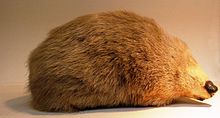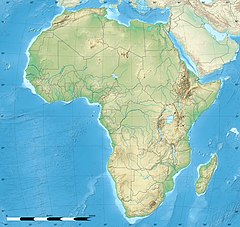Heptamegacanthus
| Heptamegacanthus | |
|---|---|
| Scientific classification | |
| Domain: | Eukaryota |
| Kingdom: | Animalia |
| Phylum: | Acanthocephala |
| Class: | Archiacanthocephala |
| Order: | Oligacanthorhynchida |
| Family: | Oligacanthorhynchidae |
| Genus: | Heptamegacanthus Spencer-Jones, 1990[1] |
| Species: | H. niekerki
|
| Binomial name | |
| Heptamegacanthus niekerki Spencer-Jones, 1990
| |
Heptamegacanthus is a monotypic genus of acanthocephalans (thorny-headed or spiny-headed parasitic worms). It contains a single species, Heptamegacanthus niekerki, parasite of the giant golden mole (Chrysospalax trevelyani) found in South Africa. Its body consists of a proboscis armed with hooks which it uses to pierce and hold the rectal wall of its host, and a short, wide body. The proboscis is armed with 40 to 45 hooks that are not radially symmetrical, with seven large anterior hooks. The hooks in the anterior ring are twice as large as those in second ring and the remaining hooks decrease progressively in size posteriorly. The worms are about 4 millimetres (0.16 in) long and 2 millimetres (0.079 in) wide.
Taxonomy
The genus Heptamegacanthus refers to its seven large hooks and the specific name niekerki derives from Jan van Niekerk, who collected the species in the field. Heptamegacanthus was placed in the Oligacanthorhynchidae family for six morphological reasons: the proboscis is subspherical; it is armed with hooks with an anterior manubrium and a strong root; sensory papillae present on the proboscis and the complex proboscis receptacle have a small, non-muscular layer and an inner large, muscular wall pierced dorsally by proboscis retractor muscles; the lemnisci are long, flat and contain several giant nuclei; there are eight cement glands, each containing a single giant nucleus; and the eggs are oval with a sculptured outer shell. It differs from other worms in the family Oligacanthorhynchidae mainly by its smaller size, and the number and greater size of hooks in the anterior ring.[1] There has been no phylogenetic analysis on Heptamegacanthus to confirm its position as a unique genus in the Oligacanthorhynchidae family. [2]
Description
H. niekerki consists of a proboscis covered in hooks, a proboscis receptacle, and a body with a length twice that of the width. Sexual dimorphism is minimal, with the male (3.49–4.23 mm long by 1.42–2.14 mm wide) being only slightly larger than female (3.15–3.59 mm long by 1.53–1.94 mm wide). This is unusual for Acanthocephalans where the female is usually much larger than the male.[1]
The proboscis is subspherical (256–381 μm long and 435–604 μm wide in males, 281–381 μm long and 416–635 μm wide in females) and is armed with 40 to 45 hooks that are not radially symmetrical, with seven large anterior hooks. There are four types of hooks: hooks in anterior 2 rings with large manubria and roots (243–275 μm long in male and 256–297 μm long in female), hooks of first ring being twice as large as those in second ring (81–180 μm long in males 103–199 μm long in females); posterior hooks spine-like, acuminate and decrease in size progressively posteriorly (43–84 μm long in males and 34–71 μm long in females to 28–52 μm long in males and 31–58 μm long in females). One sensory papilla is present on each side of neck and on the apex of the proboscis. The proboscis receptacle originates on body wall at about one quarter of body-length from the anterior end of the worm. The proboscis receptacle is single walled, having a small, non-muscular layer and inner large, muscular wall with well-developed retractor muscles penetrating receptacle wall dorsally. The brain is located in the mid-region of the proboscis receptacle. The lemnisci (bundles of sensory nerve fibers) are long, extending nearly half the body length, flat, and contain several giant nuclei (0.832–1.635 mm long and 89–333 μm wide in the female). The worm does not have protonephridia, which are found in other acanthocephalan species for excretion and water regulation.[1]
In the male, the testes are large and oblique (409–832 μm long and 204–525 μm wide) and pre-equatorial and there are eight pre-equatorial cement glands (281–404 μm long to 243–436 μm wide), which are used to temporarily close the posterior end of the female after copulation, each with a single giant nucleus. Saefftigen's pouch is club-shaped (832–877 μm long and 236–365 μm wide) and feeds into the bursa. [1]
In the female, the female reproductive system consists of a uterine bell (a funnel like opening continuous with the uterus) is large and short (179–218 μm long to 140–173 μm wide) and the uterus (396–461 μm long and 166–224 μm wide) and vagina (102–186 μm long and 32–173 μm diameter) are short and muscular, and the outer egg shell is highly sculptured. Pseudocoel contains numerous oval eggs (56–96 μm long and 43–52 μm wide) with sculptured outer shells. [1]
Distribution
The distribution of H. niekerki is determined by that of its hosts. H. niekerki has been found in South-East Africa in the Nqadu Forest, Transkei, South Africa. The host range is very limited, being an endangered species,[3] and consists only of isolated forest ranges Pirie Forest and Komgha near King William's Town, East London, and Port St. Johns in the Transkei.[1]
Hosts


The life cycle of an acanthocephalan consists of three stages beginning when an infective acanthor (development of an egg) is released from the intestines of the definitive host and then ingested by an arthropod, the intermediate host. Although the intermediate host or hosts of Heptamegacanthus are not known, the known intermediate host for the order Oligacanthorhynchidae are primarily insects. When the acanthor molts, the second stage called the acanthella (38–60 μm long and 19–26 μm wide in H. niekerki) begins. This stage involves penetrating the wall of the mesenteron or the intestine of the intermediate host and growing. The final stage is the infective cystacanth which is the larval or juvenile state of an Acanthocephalan, differing from the adult only in size and stage of sexual development. The cystacanths within the intermediate hosts are consumed by the definitive host, usually attaching to the walls of the intestines, and as adults they reproduce sexually in the intestines. The acanthor is passed in the feces of the definitive host and the cycle repeats. There are no known paratenic hosts (hosts where parasites infest but do not undergo larval development or sexual reproduction) for Heptamegacanthus.[6]
Heptamegacanthus niekerki has been found attached to the wall of the rectum in the giant golden mole.[1] There are no reported cases of H. niekerki infesting humans in the English language medical literature.[5]
Notes
References
- ^ a b c d e f g h i Jones, Mary E. Spencer (1990). "Heptamegacanthus niekerki n. g., n. sp. (Acanthocephala: Oligacanthorhynchidae) from the south-east African insectivore Chrysospalax trevelyani (Günther, 1875)". Systematic Parasitology. 15 (2): 133–140. doi:10.1007/BF00009991. S2CID 23497546.
- ^ Schoch, CL (2020). "NCBI Taxonomy: a comprehensive update on curation, resources and tools". Taxonomy Browser. NCBI. Retrieved 1 April 2024.
- ^ Bronner, G. (2015). "Chrysospalax trevelyani". IUCN Red List of Threatened Species. 2015: e.T4828A21289898. doi:10.2305/IUCN.UK.2015-2.RLTS.T4828A21289898.en. Retrieved 12 November 2021.
- ^ CDC’s Division of Parasitic Diseases and Malaria (11 April 2019). "Acanthocephaliasis". www.cdc.gov. Center for Disease Control. Archived from the original on 8 June 2023. Retrieved 17 July 2023.
- ^ a b Mathison, BA; et al. (2021). "Human Acanthocephaliasis: a Thorn in the Side of Parasite Diagnostics". J Clin Microbiol. 59 (11): e02691-20. doi:10.1128/JCM.02691-20. PMC 8525584. PMID 34076470.
- ^ Schmidt, G.D. (1985). "Development and life cycles". In Crompton, D.W.T.; Nickol, B.B. (eds.). Biology of the Acanthocephala (PDF). Cambridge: Cambridge Univ. Press. pp. 273–305. Archived (PDF) from the original on 22 July 2023. Retrieved 16 July 2023.

